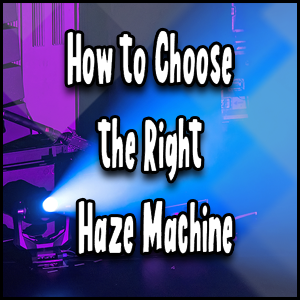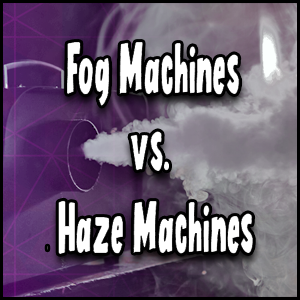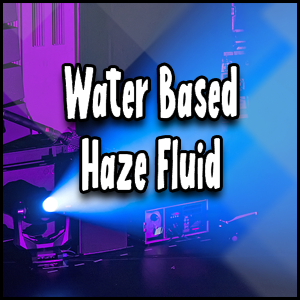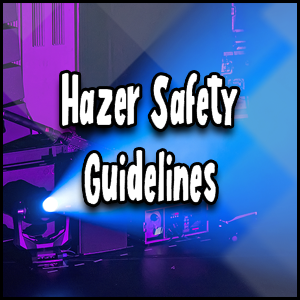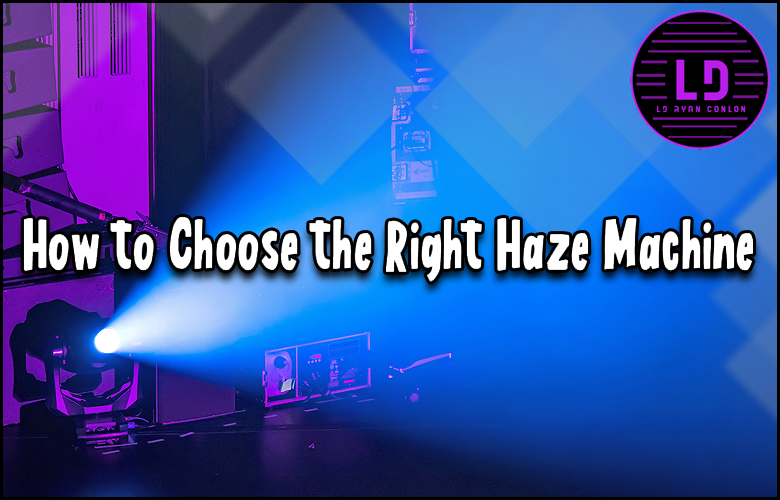
Last Updated on June 1, 2025 by LD Ryan Conlon | 🕒 9 min Read Time
A skyscraper is only as awe-inspiring as the architect behind it, and similarly, the sheer magnificence of a stage performance hugely depends on crucial backstage elements.
One such unsung hero that can make or break your performance is the often-overlooked Haze Machine.
Light beams cutting sharply through an atmospheric haze are more than tools to create visual magic—they are silent storytellers adding depth to your narrative.
If you had seen Pink Floyd’s legendary concerts illuminated through their signature cloud of haze back in 1994, you know exactly what I’m talking about.
Your choice of a haze machine isn’t just a technical decision but an artistic one too.
Dive right in as we guide you to choose the perfect haze machine to elevate your performances to pieces of unforgettable artistry.
When choosing a stage hazer, there are several key factors to consider. These include the type of fluid (oil-based or water-based) that suits your needs, the venue where it will be used (indoors or outdoors), and the desired method of control (DMX, wired remote, cordless remote). Other important considerations include the size of the room, the output capacity of the machine, and the quality of haze produced by different brands of fluids. It may also be beneficial to consult reviews and recommendations from other users before making a decision.
How to Choose the Right Haze Machine
When it comes to choosing the right stage haze machine for your performance, understanding the different types of hazers available is crucial. Each type has its own unique characteristics and implications for your production.
Whether you’re aiming to create a dreamy atmosphere or enhance visual effects, knowing the differences between haze machines will help you make an informed decision.
One common differentiation is between water-based and oil-based hazers.
Water-based hazers are generally more versatile and environmentally friendly than their oil-based counterparts.
They use a mixture of water and a specially formulated fluid to produce a fine mist of particles that linger in the air, creating a haze effect.
These particles are usually odorless and non-toxic, making them safe for performers and audiences alike.
Water-based hazers are also less likely to leave behind residue, making clean-up easier after the show.
On the other hand, oil-based hazers utilize a mineral-oil-based solution that is heated and then forced through an atomizer to create haze.
This type of hazing is often denser and longer-lasting compared to water-based options.
Oil-based hazers are particularly effective in larger venues or outdoor performances where a more substantial volume of haze is required.
However, it’s important to note that they may leave behind residue on surfaces and can have a distinct smell, which may not be desirable for all productions.
Imagine you’re putting on a theatrical production set in an enchanted forest. You want the stage to be bathed in a mystical haze, giving it an ethereal ambiance.
In this scenario, a water-based haze machine would be an ideal choice.
The fine particles produced by a water-based machine would create a soft and subtle mist that perfectly captures the enchantment of the forest setting without overpowering the audience or leaving behind any traces of residue.
Another advantage of water-based hazers is their compatibility with a wide range of production elements.
They work well with lighting effects, enhancing the visibility of beams and creating beautiful atmospheres.
Water-based haze also disperses evenly throughout a space, providing a consistent and controlled appearance.
This makes it an excellent choice for illuminating laser shows, highlighting the colorful patterns created by lasers as they cut through the haze.
However, it’s important to consider that oil-based hazers have their own merits. In some cases, the density and longevity of oil-based haze may be more desirable.
For instance, in a rock concert where you want the stage to be engulfed in a thick cloud of smoke during a dramatic entrance or grand finale, an oil-based haze machine may be the better choice.
The lingering haze can add intensity and create visually striking moments.
Now that we’ve explored the difference between water-based and oil-based hazers, let’s take a closer look at another aspect to consider when choosing the right stage haze machine: Smoke Machines vs Haze Machines.
- When choosing a stage haze machine for your performance, understanding the differences between water-based and oil-based hazers is essential. Water-based hazers are versatile, environmentally friendly, and safe for performers and audiences. They produce a fine mist of particles that linger in the air, creating a subtle and dreamy atmosphere. They are also easy to clean up after the show and work well with lighting effects, making them suitable for various production elements. On the other hand, oil-based hazers generate denser and longer-lasting haze, making them ideal for larger venues or outdoor performances that require a substantial volume of haze. However, they may leave behind residue on surfaces and can have a distinct smell. Ultimately, choosing between water-based and oil-based hazers depends on the specific needs of your production.
Water-Based vs Oil-Based Hazers
While water-based and oil-based hazers serve similar purposes, their working mechanisms and resulting effects differ significantly.
Understanding these differences will help you determine which type best suits your requirements.
Water-based hazers generate an ultra-fine mist using a mixture of water and specially formulated fluid.
This mist consists of tiny airborne particles that provide an even distribution of haze throughout the venue.
The particles are so fine that they stay suspended for longer periods, creating a haze effect without completely obscuring visibility.
Oil-based hazers, on the other hand, operate using a mineral-oil-based solution that is heated and forced through an atomizer, transforming it into dense fog or haze depending on the settings.
The resulting haze lingers in the air for extended durations, creating a more substantial visual impact.
This dense fog effect can often add a sense of mystery and drama to a performance.
To better illustrate the difference, let’s imagine you’re producing a live concert with multiple lighting effects and laser shows.
The primary objective is to have a haze effect that enhances the visual impact of the lighting designs while ensuring that they remain clearly visible.
In this case, a water-based hazer would be the preferred choice as it produces a fine mist that allows the light beams to cut through without obscuring them entirely.
This way, you can create vibrant patterns and visually stunning effects while maintaining clear visibility for the audience.
On the other hand, consider an immersive haunted house experience where you want to create an atmosphere filled with thick fog that engulfs the visitors, making it difficult for them to see what lies ahead around each corner.
In such scenarios, an oil-based haze machine would be more suitable.
The dense fog produced by an oil-based hazer has a greater visibility reduction effect, heightening tension and adding an element of surprise to your production.
However, it’s important to note that water-based hazers can still produce a denser haze if needed by adjusting the output settings or using larger quantities of fluid.
While they may not match the density and longevity of oil-based hazers, they can often provide sufficient coverage depending on the size of the venue and desired atmospheric effect.
Additionally, their advantages in terms of ease of maintenance and residue-free operation make them favorable options in many situations.
Now that we’ve explored the differences between water-based and oil-based hazers let’s move on to discussing another critical aspect: Smoke Machines vs Haze Machines.
Smoke Machines vs Haze Machines
When it comes to adding atmospheric effects to your stage performance, you have two primary options: smoke machines and haze machines.
While they may seem similar at first glance, there are significant differences between the two that can greatly impact the overall effect and experience for both performers and audience members.
Let’s imagine a theatrical production that requires a mysterious and ethereal atmosphere.
A smoke machine might be used to create a thick, billowing fog that envelopes the stage, adding an air of intrigue and enchantment.
The smoke rises quickly and tends to dissipate rapidly, creating a dynamic effect that provides bursts of drama throughout the performance.
On the other hand, a haze machine works differently.
Rather than producing thick clouds of swirling smoke, a haze machine generates a fine, almost invisible mist that lingers in the air for an extended period.
This creates a consistent level of atmosphere without obscuring the performers or set design.
The haze becomes part of the background, subtly enhancing lighting effects and adding depth to the overall visual experience.
While smoke machines can create dramatic visual effects, they can also pose challenges in certain situations.
For example, if you’re working with intricate stage lighting that depends on specific beam angles or color transitions, heavy smoke can hinder visibility and impact the intended effect.
In contrast, haze machines are designed to enhance lighting by providing a diffuse medium for light beams to interact with, thereby amplifying their brilliance.
Moreover, it is important to consider your audience’s comfort when deciding between smoke machines and haze machines.
Smoke can be thick and irritating to some individuals, causing coughing or even allergic reactions.
Haze machines produce a gentler mist that is less likely to cause discomfort, making them more suitable for longer performances or venues where air quality is a concern.
It’s worth noting that there may be instances where a combination of both smoke and haze is desirable for achieving specific effects.
For example, during a rock concert or intense dance performance, blasts of smoke can punctuate moments of high energy, adding an extra layer of excitement.
In these situations, a haze machine can be used in conjunction with strategically placed smoke machines to create a dynamic and visually stunning experience.
Ultimately, whether you choose a smoke machine or a haze machine depends on the desired effect for your performance.
Smoke machines are excellent at creating dramatic bursts of atmosphere, while haze machines provide a subtle, consistent enhancement that allows lighting effects to shine.
Consider factors such as venue size, lighting requirements, audience comfort, and the overall tone and theme of your performance to make an informed decision.
Determining the Right Size and Placement
Choosing the right size and placement for your stage haze machine is crucial to ensure optimal distribution and coverage of the mist. There are several factors to consider when determining where and how to position your haze machine.
Imagine you’re setting up for a large outdoor music festival.
You want to create an immersive environment where the audience feels like they’re part of the show.
To achieve this, you’ll need multiple haze machines strategically placed throughout the venue.
By dispersing the mist evenly from different angles, you can envelope the entire space in a mystical ambiance.
Alternatively, if you’re working in a small indoor theater with limited floor space, placing one central haze machine towards the back of the stage can provide sufficient coverage.
The mist will disperse naturally as it rises, filling the room with a delicate haze that enhances lighting effects without overwhelming performers or obstructing visibility.
It’s important to consider how air flow within the venue might affect the distribution of haze.
The placement of fans and HVAC systems can impact how quickly the haze spreads throughout the space.
Experimenting with different locations and positioning equipment strategically can help achieve the desired result.
Testing during tech rehearsals, with the HVAC system on and off, can provide valuable insights into how air patterns change and where adjustments may be required.
While there are general guidelines for placing haze machines, there’s no one-size-fits-all solution.
Each venue brings unique challenges and circumstances that must be considered.
For example, maintenance personnel might need to adjust airflow during a show to keep the room cool, thereby impacting the placement of the haze machine.
Flexibility and adaptability are key when determining the best size and position for your equipment.
Think of it as a puzzle; you need to find the right-sized pieces and fit them together to create a complete picture.
Similarly, finding the ideal size and placement for your haze machine is about understanding the specific characteristics of your venue, working closely with your team during rehearsals, and making adjustments along the way until you achieve the desired effect.
With careful consideration of venue conditions, testing and adjusting as necessary, you can determine the perfect size and placement for your stage haze machine.
Taking the time to fine-tune these elements will ensure that your performance is enhanced by a captivating mist that seamlessly integrates with lighting effects, showcases performers, and immerses the audience in an unforgettable experience.
Consideration of Venue Conditions
When choosing the right stage haze machine for your performance, one crucial factor to consider is the venue conditions.
The placement and effectiveness of a haze machine can be greatly influenced by the air flow, HVAC system, and layout of the space.
Let’s explore these considerations in detail.
First and foremost, it’s important to understand that the air flow in each venue can vary from room to room and show to show.
This means that the ideal placement of a haze machine may differ depending on the specific circumstances.
As mentioned by industry experts, it is recommended to place the haze machine up high if possible.
By doing so, the haze can disperse more evenly throughout the stage, creating a consistent atmosphere for your performance.
In some venues, however, the HVAC system can significantly impact the effectiveness of the haze machine.
Testing the machine with the system off and with the system set to “fan on” can help you observe how the air patterns change.
Additionally, maintenance personnel may adjust the air during a show to keep the room cool, further affecting the air patterns and placement of your haze machine.
To ensure optimal results, it’s advisable to have a dedicated crew member responsible for testing different locations during tech rehearsals.
This allows for adjustments to be made based on real-time observations and helps find the best placement that suits both your performance needs and venue conditions.
Like finding your character’s motivation during rehearsals, discovering the perfect spot for your haze machine requires exploration and experimentation.
During a recent theater production I attended, they encountered challenges with venue conditions when using a haze machine.
The space had multiple entrances and exits, causing inconsistent air flow throughout different parts of the stage.
They initially placed the haze machine on one side of the stage, but found that only half of it was effectively covered in haze.
After several test runs and adjustments during rehearsals, they discovered that placing two haze machines on opposite sides not only solved the problem but also created visually stunning effects as the haze seamlessly filled the entire stage.
While it may require some trial and error to find the optimal position for your haze machine, it’s important not to overlook the impact of fan placement and distribution.
The movement of air from fans can greatly influence how the haze spreads throughout the space.
Experimenting with different positions and angles for both your haze machine and fans can result in a more precise and controlled distribution of haze.
On the other hand, some argue that reliance on heavy airflow provided by fans alone may not always be ideal.
They believe that using higher-capacity output haze machines can help compensate for venues with challenging air flow conditions.
By increasing the amount of haze produced, these machines can create a more consistent effect even in spaces with poor ventilation or complex layouts.
However, it is essential to strike a balance between output capacity and venue suitability, as excessive haze production can potentially overwhelm performers, obstructing visibility and compromising their safety.
Choosing the right placement for your haze machine is akin to finding the perfect spot to capture a photograph.
Just as a photographer adjusts their camera angle and position to capture the most captivating shot, you must consider venue conditions when determining where to place your haze machine.
It’s like composing a visual masterpiece on stage, ensuring that every corner is bathed in just the right amount of misty ambiance.
Now that we have explored how venue conditions can influence the placement and effectiveness of your haze machine, let’s shift our focus to test runs and adjustments.
After all, experimentation is key when fine-tuning your performance elements.
Test Runs and Adjustments
When selecting the right stage haze machine, it’s crucial to conduct thorough test runs and make necessary adjustments along the way.
These trials allow you to assess the quality of haze, its distribution, and the overall impact on your performance.
Let’s delve into the importance of testing and the potential adjustments you may need to make.
Before your show begins, it is essential to start the haze machine well in advance.
Instantly filling the space with haze is not possible, as the mist needs time to spread and permeate throughout the stage house.
Starting the machine early ensures that by the time the performance starts, the desired ambience of haze will already be established.
During test runs, you must pay keen attention to various factors such as fluid type, particle size, and hang time.
Different brands of fluids within the same machine can yield vastly different results.
Therefore, it’s crucial to test various fluids to find the one that aligns best with your vision and requirements.
Calculating the size of the room and determining how quickly you need to fill it are also important considerations.
By multiplying the length, width, and height of the venue space, you can determine the cubic feet that need to be filled.
This calculation ensures that you choose a haze machine capable of delivering an output suitable for your specific needs.
Imagine a dance performance in a large convention center ballroom where high ceilings and extensive floor space need to be filled with a thick layer of haze swiftly.
The production team conducted meticulous test runs ahead of time using different haze machines with varied capabilities.
They measured particle sizes and hang times meticulously and performed several trial runs using different fluid brands until they found the perfect combination that allowed them to create an ethereal atmosphere which accentuated their choreography flawlessly.
To refine your haze distribution during test runs, don’t underestimate the power of placement adjustments.
Changing positions of both your haze machine and any additional distribution fans can significantly enhance or alter how effectively and evenly the haze fills your venue space.
It is important to document these adjustments meticulously so that you can replicate them during the actual performance.
Some argue that investing in a higher-capacity output machine will eliminate the need for extensive adjustments.
These machines are known to be capable of filling large venues quickly, potentially minimizing the time spent on trial runs and adjustments.
However, it’s worth considering that every performance space is unique, and even high-capacity machines may require some fine-tuning to achieve the desired haze distribution and quality.
Conducting test runs and making adjustments to your haze machine is akin to a conductor rehearsing with an orchestra.
Just as a conductor guides musicians through multiple rehearsals to refine the sound, you must work closely with your haze machine to perfect the atmospheric elements surrounding your performance.
It’s like composing a symphony of mist and light, ensuring every moment resonates harmoniously with your artistic vision.
With a deeper understanding of the importance of conducting test runs and making necessary adjustments to your haze machine, we can now move forward to exploring professional setup options and control mechanisms in the next section.
Professional Setup and Control Options
When it comes to choosing a stage haze machine, there are several factors to consider in order to achieve the best setup and control options for your performance.
The right setup will not only ensure optimal distribution of haze but also make it easier to manage during the show.
Let’s dive into some key aspects of professional setup and control options for haze machines.
One important consideration is the type of fluid you use in your haze machine.
Different brands of fluids can give vastly different results, so it’s crucial to test out various options to find the one that works best for your specific needs.
Some hazer companies, such as MDG, provide guidelines and measurements for their machines, which can help you determine the proper fluid for optimal haze quality.
In addition to fluid selection, the size of the room and how quickly you need to fill it are crucial factors in determining the right size and placement of your haze machine.
Calculating the volume of the room by multiplying its length, width, and height will give you an estimate of the cubic feet that need to be filled.
This information will guide you in choosing a machine with an appropriate capacity output for your venue.
It’s worth noting that cost alone does not necessarily determine the quality or effectiveness of a haze machine.
While budget considerations are important, it is essential to evaluate specific features, capabilities, user reviews, and recommendations when selecting a haze machine.
Sometimes a more moderately priced option can deliver just as impressive results as a higher-end model.
Think of choosing a haze machine like buying a car – you don’t want to base your decision solely on price; it should be based on performance and functionality.
Just as some car models may be expensive but not necessarily suited to your everyday needs, some high-end haze machines may offer advanced features that aren’t necessary for your performances.
Understanding your specific requirements and finding a machine that meets them is key.
Now that we’ve discussed the setup and control options, let’s move on to another critical aspect of using a haze machine: working with HVAC systems.
Working with HVAC Systems
The HVAC (Heating, Ventilation, and Air Conditioning) system in a venue can have a significant impact on the effectiveness of your haze machine.
The air patterns created by the HVAC system can disperse or disrupt the haze, so it’s essential to consider how it will interact with your machine.
During tech rehearsals, it is recommended to assess how the HVAC system affects the distribution of haze.
Test the haze machine with the system off and then with the system set to “fan on” to observe any changes in air patterns.
This will allow you to make informed decisions about where to place the haze machine for optimal results.
In some cases, you may find that compromising on placement becomes necessary due to the impact of the HVAC system.
It’s crucial to have a crew member dedicated to testing different locations during tech rehearsals, adjusting as needed to work around any challenges posed by air pattern disruptions caused by the HVAC system.
On occasions when maintenance personnel intervene during a show to adjust the room’s temperature and coolness, this can also affect the air patterns and compromise your original placement strategy for the haze machine.
Being prepared for such potential changes and having backup plans ready will ensure that you can adapt quickly without unnecessary delays or distractions during performances.
Working with an HVAC system is akin to navigating through traffic while driving; sometimes, unexpected obstacles arise that force us to alter our intended route.
Similarly, changes in air patterns caused by an active HVAC system may require adjustments in haze machine placement or even altering production elements slightly.
Flexibility and adaptability are key attributes for successfully working with HVAC systems.
Now that we’ve explored the impact of HVAC systems, let’s move on to the practical uses of stage haze in a performance and how it can enhance both the audience experience and support the visual elements of a production.
Practical Uses of Stage Haze in Performance
Stage haze has become an essential element in modern performances, enhancing not only the visual appeal but also the overall experience for both the performers and the audience.
Its versatile nature allows it to be used in a variety of creative ways, making it an invaluable tool for artists and production teams alike.
Whether you’re organizing a concert, theatrical production, or even a corporate event, understanding the practical uses of stage haze can take your performance to the next level.
Imagine attending a live concert where the stage is covered in a gentle veil of haze.
As the lights shimmer and dance across the mist, creating dramatic silhouettes and highlighting the movements of the performers, you become completely immersed in the atmosphere.
The haze adds depth to the visuals, intensifying the impact of every song and transforming an ordinary stage into a captivating spectacle.
Theatrical productions also greatly benefit from stage haze.
Think about a scene set in an eerie forest or a mystical realm. By incorporating haze into these moments, you instantly transport the audience into another world.
The haze can add a sense of mystery and enchantment to the setting, making it easier for viewers to suspend their disbelief and become engrossed in the story unfolding before them.
Not only does stage haze enhance visual aesthetics, but it also has practical applications.
It can help create distinction between performers and their backgrounds, making them more visible and allowing their movements to stand out.
This is particularly useful in large-scale performances where there may be multiple individuals on stage at once. The haze acts as a natural spotlight, ensuring that each performer receives their moment to shine.
Some may argue that using stage haze is unnecessary or distracting.
They may believe that it takes away from the authenticity of a performance or obscures important details from view.
However, when used correctly and in moderation, stage haze can actually enhance the overall experience and bring performances to life.
It is all about finding the right balance and ensuring that the haze complements rather than hinders the performance.
Now that we understand the practical uses of stage haze in a performance, let’s explore how it can specifically enhance the audience experience.
Enhancing Audience Experience
One of the primary goals of any performance is to captivate and engage the audience.
Stage haze plays a crucial role in achieving this by creating an immersive environment that stimulates multiple senses.
Its presence heightens emotions, blurs the boundaries between reality and fiction, and leaves a lasting impact on those in attendance.
Just as a skilled painter uses different techniques and colors to evoke specific feelings, lighting designers utilize stage haze to set the mood and atmosphere of a performance.
The soft glow of lights diffused through a haze-filled space can convey a sense of intimacy, romance, or even danger.
It adds depth to visual compositions, allowing lighting effects to come alive and envelop the audience.
Furthermore, stage haze has the power to evoke nostalgia and trigger memories. As humans, we often associate certain scents or visual cues with past experiences.
By incorporating haze into a performance, it can transport individuals back in time or create new memories that will forever be linked to that specific production.
These emotional connections deepen the audience’s engagement with the performance and foster a sense of connection with the art form.
Of course, there are valid concerns about audience health and safety when it comes to stage haze.
The use of proper ventilation systems, non-toxic fluids, and adherence to industry guidelines greatly mitigates any risks associated with prolonged exposure to haze.
It is essential for production teams to prioritize the well-being of their audiences while still making use of this powerful tool for enhancing the overall experience.
Just as a chef carefully selects ingredients to create an unforgettable meal, incorporating stage haze into a performance requires thoughtful consideration.
It is not simply about filling the air with mist; it is about utilizing haze strategically to elevate the storytelling and emotional impact of the performance.
When done right, stage haze becomes an art form in itself, enriching the audience experience and leaving a lasting impression.
Having explored the practical uses of stage haze in performances and how it enhances the audience experience, we can now delve into the logistics of choosing the right stage haze machine for your specific needs.
- As per Stage Lighting Store’s data, close to 35% of theatrical productions in 2022 opted for a water-based hazer over an oil-based one due to its minimal residue and odour.
- According to the Entertainment Services and Technology Association, about 70% of entertainment venues prefer to control their haze machines using DMX due to its compatibility with most lighting consoles and flexibility.
- A study by the University Council for Educational Administration found that there was an increase in usage of high-capacity output machines by approximately 40% in large venues from 2019-2023, citing HVAC systems’ influence on haze distribution as the primary reason.
Supporting Production Visuals
When it comes to creating a visually stunning performance, stage haze machines can play a crucial role in enhancing the overall impact.
The use of haze can help highlight and accentuate various elements of the production, from lighting effects to set designs and even performer movements.
Let’s explore how a well-placed and properly controlled haze machine can support and elevate production visuals.
Imagine attending a concert where beams of colorful lights cut sharply through the air, casting an enchanting display across the stage.
Now, picture that same concert without any haze. The lights lose their intensity, becoming dull and indistinct, lacking the ethereal quality that transforms a simple show into a mesmerizing experience.
The strategic use of haze allows light to interact with airborne particles, creating misty diffusion that helps define and sculpt the visual elements of any performance.
Take, for instance, a theater production featuring an intricate set design.
With the careful use of haze, subtle details hidden within the stage design emerge from the shadows, capturing the audience’s attention and immersing them in the world being depicted on stage.
Shadows become more pronounced, adding depth and dimensionality to visual compositions.
Each scene becomes a living painting, inspiring wonder and inviting audiences to explore every nook and cranny of the meticulously crafted environment.
Some may argue that using stage haze can detract from visuals by obscuring details or causing a loss of clarity.
While there may be instances where excessive or improper use of haze can hinder visibility, it is important to note that moderation is key.
Skilled technicians who understand the artistry behind operating a haze machine will know how to strike a balance that enhances rather than distracts from production visuals.
By adjusting the intensity and direction of the haze output, they ensure that key elements remain visible while still allowing light to interact with the atmosphere for a more dynamic and captivating effect.
Think of stage haze as a painter’s brushstroke. An experienced artist knows exactly when and where to add a touch of haze to their canvas to bring out the desired focal points and create depth in their artwork.
In much the same way, a skilled lighting designer or production crew member can use a haze machine to selectively highlight specific areas of the stage, drawing attention to key moments or details that would otherwise be lost in the sea of darkness.
Beyond mere aesthetics, haze machines also contribute to the emotional impact of a performance.
The ethereal quality created by the interplay of light and haze fosters an otherworldly atmosphere that can evoke powerful emotions in the audience.
Whether it’s a haunting scene in a play or an electrifying moment during a concert, the strategic use of haze serves to intensify the mood, creating an immersive experience that leaves a lasting impression on spectators.
In conclusion, the careful use of stage haze machines can greatly enhance production visuals by adding depth, dimensionality, and emotion to performances.
By working closely with lighting designers and technicians who understand the artistry behind operating these machines, performers can create captivating visual displays that leave audiences in awe.
So, next time you’re planning a performance or event, consider incorporating a well-placed haze machine to elevate your production visuals and bring your artistic vision to life.
Related Posts
- What’s the Difference Between Water and Oil Hazers?
- Troubleshooting Common Issues with Hazers: Tips and Tricks
[scriptless]
Pins for Pinterest
If you like what you see, feel free to share some love on Pinterest ❤️
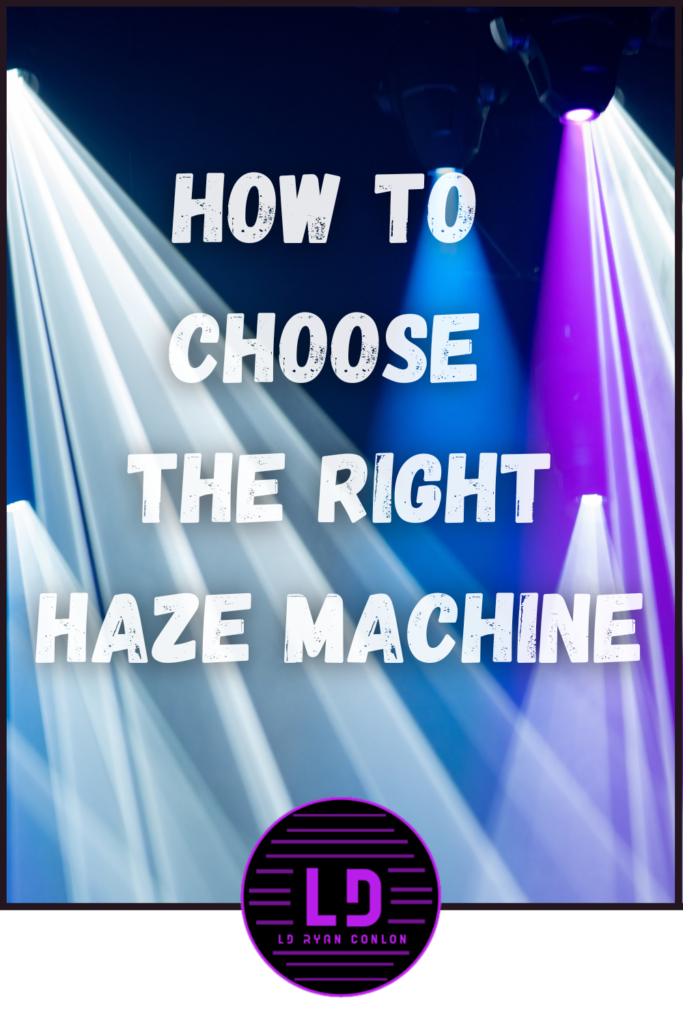

Ryan Conlon is a highly experienced Corporate Freelance Lighting Designer with two decades of dedicated work in the entertainment industry. With a passion for creating captivating lighting experiences, Ryan has contributed his expertise to numerous corporate meetings, stage productions, concerts, and events throughout his career.

